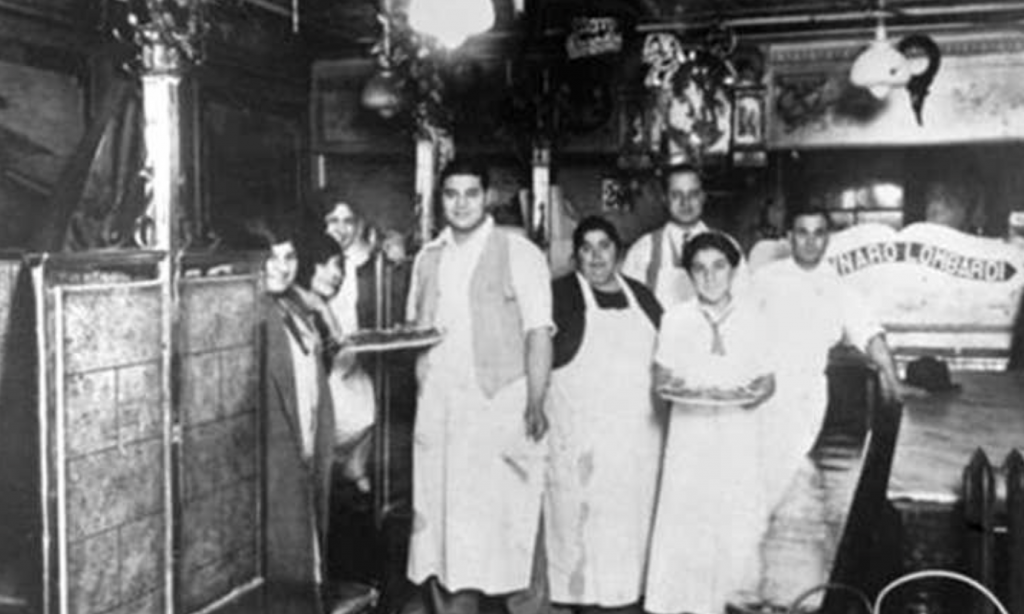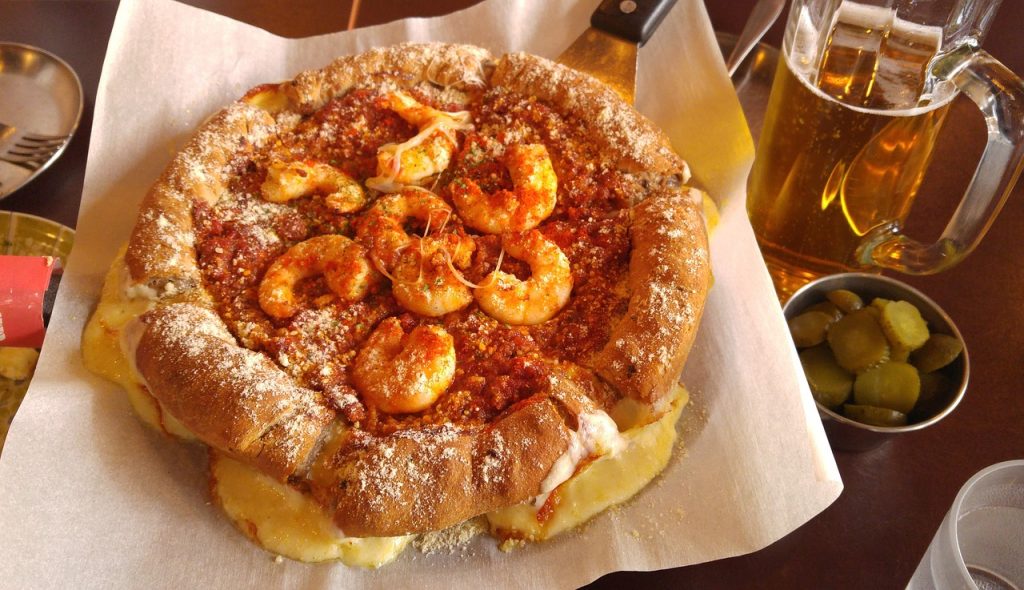Who Invented Pizza?
Learn who invented pizza. Find out who truly deserves the credit for the divine creation.
This article is more than 2 years old

Pizza is an enormous part of American culture. That sentiment is evident in the approximately 74,000 pizzerias that line the nation’s streets. From mom-and-pop establishments and large chain entities like Domino’s, Pizza Hut, and Papa John’s to the frozen varieties that dominate the freezer real estate at your local grocery store, pizza is everywhere. And with around 93% of individuals in the United States having eaten at least one slice of pizza in the past month, it’s hard to imagine a time when pizza didn’t exist. Yet, believe it or not, pizza, as we know it today, is a relatively modern concoction. Which begs the question, who invented pizza? Who truly deserves the credit for imbuing the word’s populous with such a mouthwatering combination of ingredients? Well, the answers to those questions are not as cut and dry as one might think.
VERY EARLY INKLINGS

Pizza in its most primitive form hails back to antiquity. Ancient Roman, Greek, and Egyptian lore frequently makes reference to thin, soft, wheat cakes akin to focaccia that were enjoyed with an array of toppings (typically herbs) and drizzles of oil. This premise of eating bread made more delicious by enhancing it with toppings was the very foundation of what would become modern pizza. However, while the ancient peoples of Rome, Greece, and Egypt can lay claim to laying the groundwork for pizza, they were technically not who invented pizza.
THANK NAPLES FOR THE STAPLES

Every pizza lover out there owes a big thank you to the Lazzaroni, or working-class poor, of Naples. Sometime between the late 1700s and early 1800s, these folks were the ones who invented pizza as a cost-effective means of feeding themselves during the long days they spent working on the shores of the waterfront city. These hard-working Lazzaroni would feast on soft doughy bread topped with fixings not dissimilar from the types we enjoy today. Most commonly, these early pizzas were adorned with tomato, anchovies, garlic, oils, and sometimes sprinkled with cheese.
While the Lazzaroni’s creation might sound delicious today, higher-class Italians of the era found their concoction repulsive. As a result, pizza remained largely sequestered within Naples’ poor working-class societal sector. That is until King Umberto I and Queen Margherita gave it a chance. In 1889, the royal pair went on holiday to Naples and indulged in a range of local varieties of pizza.

However, Queen Margherita gravitated towards a certain variety she was served at Pizzeria Brandi. The type that she had developed a quick affinity for was characterized by fresh tomatoes adorned with helpings of fresh mozzarella and garnished with fresh basil. All of the fresh ingredients made the pizza taste light, airy, and divinely delicious. As a result of her taking a liking to the pizza, from then on that particular pie came to be known as Pizza Margherita. Queen Margherita, perhaps, can be credited as the person who invented the first regional style of pizza.
NEW YORK’S PIZZA PIONEER

A wave of Neapolitan immigrants made their way to the shores of New York City in the latter part of the 1800s and early 1900s. Naturally, those immigrating from Naples brought their culture and customs with them, including their adoration for Pizza. Hence, when they arrived in the city they began making pizza with the ingredients that were available and readily affordable to them.
Gennaro Lombardi is credited as the person who invented pizza as it came to be known in New York City. When he opened Lombardi’s in 1905 on Spring Street in Little Italy, he became the first person to serve up the initial New York Style Pie. New York Style pizza is characterized by a hand-tossed, thin, soft, foldable crust slathered in a generous amount of tomato sauce and topped off with a nice heap of mozzarella cheese evenly distributed around the pie. Lombardi’s is still in operation today.

Lombardi, being a pioneer of early pizzerias in the states, inspired other Italian immigrants to open up their own establishments. Throughout the 1910s, 1920s, and 1930s pizzerias began to dot the boroughs of New York City and the surrounding areas of New Jersey, Connecticut, Pennsylvania, and Massachusetts, all of them serving up their own variations of the classic New York slice.
CHICAGO’S CREATOR

Pizza really took off in the United States following the return of American soldiers after the conclusion of WWII. During the war, soldiers stationed in Naples took a liking to the combinations of dough, sauce, cheese, and other toppings that they were serving up. This overseas introduction caused pizza’s popularity to explode in the states. Suddenly new styles of pizza began to crop up in areas well outside of the US’ northeastern corridor.
Chicago-style pizza was one of the first regional variations to be developed in the wake of WWII. Chicago-style pizza is a type of deep dish pizza that is baked in a pan in order to yield a super soft, pillowy, dense crust. Chicago deep-dish is assembled in reverse, with the cheese resting on the bottom, followed by the tomato sauce and any other toppings.
Who invented pizza as it came to be enjoyed in Chicago, however, is still widely up for debate. Tim Samuelson, Chicago’s appointed cultural historian, detailed that there are too many conflicting accounts to be certain. Still, the widely accepted theory is that Ike Sewell, the founder of Pizzeria Uno, is the one who invented the style when he founded the restaurant in 1943.
DETROIT’S DESIGNER

While the creator of Chicago’s signature deep-dish style pizza may be up for debate, Detroit has a definitive answer to who invented pizza hailing from the great motor city. Gus Guerra and his wife Anna are the father and mother of Detroit-style pizza pie. In 1946, Guerra was running a bar called Buddy’s Rendezvous. In an effort to revitalize the menu, Guerra was trying to come up with new dishes that the bar could offer patrons. Guerra turned to his wife Anna for help in coming up with ideas.
In a stroke of pizza genius, Anna consulted her Sicilian roots and obtained an old recipe from her mother. The pair adapted the recipe to craft the very first Detroit-style pizza. This regional variety of pizza is also assembled upside down with the toppings going on the very bottom (most often pepperoni) followed by the cheese. The cheese is applied all the way to the very edges so that it hardens and caramelizes during the cooking process. Then the pie is topped off with heaping ladles of tomato sauce. As an homage to the city’s vehicular history, the most defining trait of Detroit style pizza, coined by those who invented pizza of this variety, is that it is cooked in square pans used for storing automotive parts
THE CONCLUSION

Pizza is truly the world’s food. The credit of who invented pizza belongs to the tales from antiquity, the Lazzaroni’s work ethic, Italian immigrants who nurtured and shared their culture, and innovators unafraid to put their own spin on something delicious. Besides the big three varieties, you’ll find numerous others in the United States including St. Louis and California. Countries across the globe have also developed their very own regional variations of the simple, yet divine combination of ingredients. So, who invented pizza? The early working class in Naples. They are the ones who first got the dough rolling. However, the world’s people are who truly elevated pizza to the height it sits at today.




